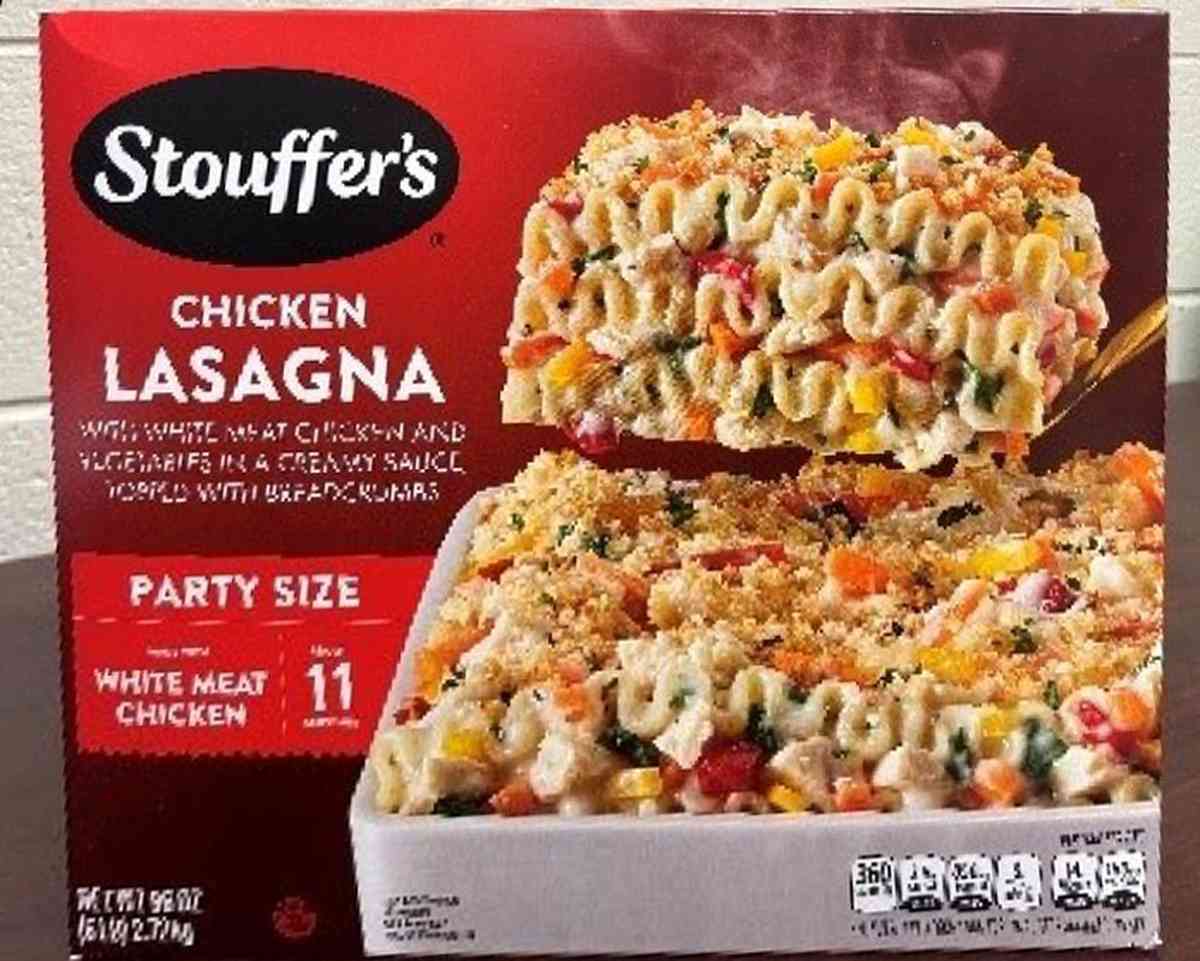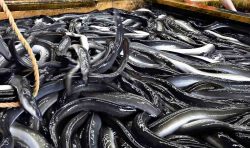
Stouffer’s Party Size Chicken Lasagna.
13:43 JST, March 29, 2025
Metal scraps, rubber pieces and bits of permanent marker sound like the contents of a trash can, not your grocery cart. But those items have turned up in chicken nuggets, veggie burgers and other foods in recent months, prompting a rash of alerts and recalls.
Just this year, at least a dozen companies’ products have been flagged as potentially containing what regulators often call “foreign objects,” according to notices posted by the U.S. Department of Agriculture and the Food and Drug Administration.
The makers of Chef’s Line black bean and grain burgers and sliders recalled nearly 75,000 cases of their products because of the possible presence of a metal bolt, which carries a choking risk. And last week Nestle announced that it had recalled several of its frozen meals after customers complained about finding “wood-like material.” The products the company pulled were Lean Cuisine Butternut Squash Ravioli, Spinach Artichoke Ravioli and Lemon Garlic Shrimp Stir Fry, as well as Stouffer’s brand Party Size Chicken Lasagna. The company said there had been “one potential choking incident to date.”
On March 7, a maker of Johnsonville turkey kielbasa recalled 35,000 pounds of the sausage, saying it may be contaminated with “pieces of rubber,” which the company said had not caused any known injuries.
While many consumers might think of food recalls being prompted by pathogens – such as last year’s deadly listeria outbreak tied to Boar’s Head deli meats – foreign-object contaminations can be alarming, too.
Amy Johnston, an extension educator in food safety at the University of Minnesota, said bits of metal or plastic could come from faulty equipment or errors in production. “Still, human error is the leading cause of food contamination and illness, no matter the type of hazard,” she said. “It may be that the food manufacturer doesn’t have an appropriate preventative maintenance plan in place, or maybe they’re not following it so they’re not catching routine things that keep equipment working.”
For many eaters, the prospect of finding metal in their food is particularly disturbing. The maker of Chomps Original Beef Sticks on Thursday said that it was recalling nearly 30,000 pounds of products that may contain metal, the USDA announced, after two consumers complained. And bags of shredded Colby Jack cheese were pulled last month from Aldi stores because of the potential presence of stainless-steel fragments, according to the FDA.
“The biggest concern tends to be metal because that can be very dangerous if somebody chewed on it or swallowed it, and it’s also so present in the manufacturing process,” said Barbara Kowalcyk, director of George Washington University’s Institute for Food Safety and Nutrition Security. She said some companies use X-ray scans to detect errant metal items, but other potential contaminants can be harder to screen for.
Office supplies have turned up in at least two instances: Earlier this month, a consumer who found “hard plastic from a permanent marker pen” in Trader Joe’s steamed chicken soup dumplings kicked off a recall of that product. In January, D.J.’s Boudain removed nearly 18,000 pounds of sausage link products that may be contaminated with “pieces of a pen” that caused at least one “oral injury,” according to the USDA.
Federal regulators assume that no matter how careful manufacturers are, some contaminants will find their way into various foods. “It is economically impractical to grow, harvest, or process raw products that are totally free of non-hazardous, naturally occurring, unavoidable defects,” the USDA says in a handbook outlining acceptable levels of things, such as bugs and stems, that might be present in food.
While every instance is different, Johnston said that staffing shortages, which many companies have struggled with, could contribute to the problem of more hazardous items turning up in grocery stores. And she noted that it’s easier than ever for consumers who find foreign objects to look up how to report them.
“The cadence of it does feel more frequent,” she said. “It’s probably a combination of all of the things, including consumers being savvier as well as staffing challenges, which has a trickle-down effect, if there’s inadequate training or rushed training that leads to the human error.”
Kowalcyk said she feared that efforts to trim government spending could leave consumers more vulnerable. Now, inspectors require companies to have food safety plans tailored to their facilities, which she said should take into account the potential for physical contaminants. “But prevention is really hard to demonstrate an ROI on, and so it’s often put on the chopping block first,” she said, using the acronym for return on investment. “People might think: ‘We haven’t had our problem in a long time. So why do we need to keep spending this money?’”
"News Services" POPULAR ARTICLE
-

American Playwright Jeremy O. Harris Arrested in Japan on Alleged Drug Smuggling
-

Japan’s Nikkei Stock Average as JGB Yields, Yen Rise on Rate-Hike Bets
-

Japan’s Nikkei Stock Average Licks Wounds after Selloff Sparked by BOJ Hike Bets (UPDATE 1)
-

Japanese Bond Yields Zoom, Stocks Slide as Rate Hike Looms
-

Japan’s Nikkei Stock Average Buoyed by Stable Yen; SoftBank’s Slide Caps Gains (UPDATE 1)
JN ACCESS RANKING
-

Keidanren Chairman Yoshinobu Tsutsui Visits Kashiwazaki-Kariwa Nuclear Power Plant; Inspects New Emergency Safety System
-

Imports of Rare Earths from China Facing Delays, May Be Caused by Deterioration of Japan-China Relations
-

University of Tokyo Professor Discusses Japanese Economic Security in Interview Ahead of Forum
-

Japan Pulls out of Vietnam Nuclear Project, Complicating Hanoi’s Power Plans
-

Govt Aims to Expand NISA Program Lineup, Abolish Age Restriction
























